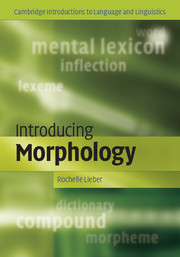Book contents
- Frontmatter
- Contents
- Preface
- The International Phonetic Alphabet
- Point and manner of articulation of English consonants and vowels
- 1 What is morphology?
- 2 Words, dictionaries, and the mental lexicon
- 3 Lexeme formation: the familiar
- 4 Productivity and creativity
- 5 Lexeme formation: further afield
- 6 Inflection
- 7 Typology
- 8 Words and sentences: the interface between morphology and syntax
- 9 Sounds and shapes: the interface between morphology and phonology
- 10 Theoretical challenges
- Glossary
- References
- Index
1 - What is morphology?
- Frontmatter
- Contents
- Preface
- The International Phonetic Alphabet
- Point and manner of articulation of English consonants and vowels
- 1 What is morphology?
- 2 Words, dictionaries, and the mental lexicon
- 3 Lexeme formation: the familiar
- 4 Productivity and creativity
- 5 Lexeme formation: further afield
- 6 Inflection
- 7 Typology
- 8 Words and sentences: the interface between morphology and syntax
- 9 Sounds and shapes: the interface between morphology and phonology
- 10 Theoretical challenges
- Glossary
- References
- Index
Summary
CHAPTER OUTLINE
In this chapter you will learn what morphology is, namely the study of word formation.
We will look at the distinction between words and morphemes, between types, tokens, and lexemes and between inflection and derivation.
We will also consider the reasons why languages have morphology.
KEY TERMS
morpheme, simplex, complex, type, token, lexeme, word form, inflection, derivation
Introduction
The short answer to the question with which we begin this text is that morphology is the study of word formation, including the ways new words are coined in the languages of the world, and the way forms of words are varied depending on how they're used in sentences. As a native speaker of your language you have intuitive knowledge of how to form new words, and every day you recognize and understand new words that you've never heard before.
Stop and think a minute:
Suppose that splinch is a verb that means ‘step on broken glass’; what is its past tense?
Speakers of English use the suffixes -ize (crystallize) and -ify (codify) to form verbs from nouns. If you had to form a verb that means ‘do something the way ex-Prime Minister Tony Blair does it’, which suffix would you use? How about a verb meaning ‘do something the way ex-President Bill Clinton does it’?
It's possible to rewash or reheat something. Is it possible to relove, reexplode, or rewiggle something?
- Type
- Chapter
- Information
- Introducing Morphology , pp. 1 - 10Publisher: Cambridge University PressPrint publication year: 2009

